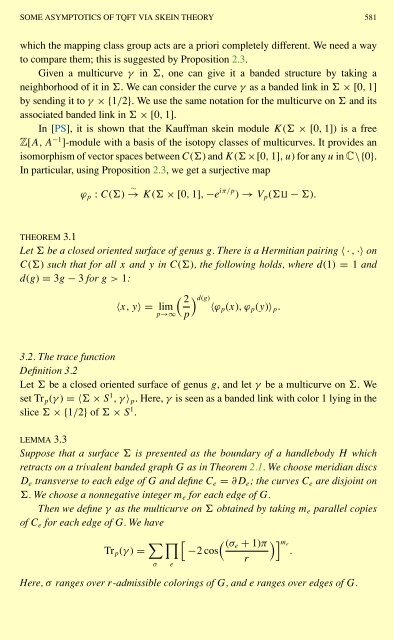A NULLSTELLENSATZ FOR AMOEBAS
A NULLSTELLENSATZ FOR AMOEBAS
A NULLSTELLENSATZ FOR AMOEBAS
You also want an ePaper? Increase the reach of your titles
YUMPU automatically turns print PDFs into web optimized ePapers that Google loves.
SOME ASYMPTOTICS OF TQFT VIA SKEIN THEORY 581<br />
which the mapping class group acts are a priori completely different. We need a way<br />
to compare them; this is suggested by Proposition 2.3.<br />
Given a multicurve γ in , one can give it a banded structure by taking a<br />
neighborhood of it in . We can consider the curve γ as a banded link in × [0, 1]<br />
by sending it to γ ×{1/2}. We use the same notation for the multicurve on and its<br />
associated banded link in × [0, 1].<br />
In [PS], it is shown that the Kauffman skein module K( × [0, 1]) is a free<br />
Z[A, A −1 ]-module with a basis of the isotopy classes of multicurves. It provides an<br />
isomorphism of vector spaces between C() and K( ×[0, 1],u) for any u in C\{0}.<br />
In particular, using Proposition 2.3, we get a surjective map<br />
ϕ p : C() ∼ → K( × [0, 1], −e iπ/p ) → V p (∐ − ).<br />
THEOREM 3.1<br />
Let be a closed oriented surface of genus g. There is a Hermitian pairing 〈·, ·〉 on<br />
C() such that for all x and y in C(), the following holds, where d(1) = 1 and<br />
d(g) = 3g − 3 for g>1:<br />
2<br />
) d(g)〈ϕp<br />
〈x,y〉= lim (x),ϕ<br />
p→∞(<br />
p (y)〉 p .<br />
p<br />
3.2. The trace function<br />
Definition 3.2<br />
Let be a closed oriented surface of genus g, andletγ be a multicurve on . We<br />
set Tr p (γ ) =〈 × S 1 ,γ〉 p . Here, γ is seen as a banded link with color 1 lying in the<br />
slice ×{1/2} of × S 1 .<br />
LEMMA 3.3<br />
Suppose that a surface is presented as the boundary of a handlebody H which<br />
retracts on a trivalent banded graph G as in Theorem 2.1. We choose meridian discs<br />
D e transverse to each edge of G and define C e = ∂D e ; the curves C e are disjoint on<br />
. We choose a nonnegative integer m e for each edge of G.<br />
Then we define γ as the multicurve on obtained by taking m e parallel copies<br />
of C e for each edge of G. We have<br />
Tr p (γ ) = ∑ σ<br />
∏<br />
e<br />
[ ( (σe + 1)π<br />
−2 cos<br />
r<br />
)] me.<br />
Here, σ ranges over r-admissible colorings of G, and e ranges over edges of G.
















